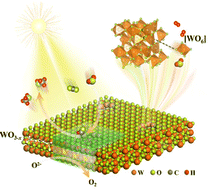Pit-embellished low-valent metal active sites customize CO2 photoreduction to methanol†
Abstract
Customizing catalytic reaction pathways by precisely designing the metal active sites and electron–hole separated channels of metal oxides to simultaneously achieve a high yield and selectivity of photocatalytic CO2 reduction to liquid fuel remains a challenge. Herein, we for the first time propose that low-valent tungsten sites favor the formation of key CHO* intermediates for highly selective photocatalytic reduction of CO2 to CH3OH. In situ spectroscopic results and DFT calculations demonstrate that coordinately unsaturated low-valent W sites near the tungsten trioxide (denoted WO3−x) pits serve as catalytic sites and electron capture sites enabling the adsorbed CO2 to selectively form a predominant lower-energy *CHO intermediate instead of *CO, thereby triggering a unique reaction pathway for CO2 reduction to CH3OH. Accordingly, the optimal WO3−x delivers a notable CH3OH selectivity of up to 86% with a high evolution rate of 17 μmol g−1 h−1 under sunlight irradiation. This work highlights how low-valent metal active sites in the surface pits can be controlled at the atomic-level to customize the CO2 reduction reaction (CO2RR) pathway to generate valuable liquid fuels.

- This article is part of the themed collection: Carbon Dioxide utilisation


 Please wait while we load your content...
Please wait while we load your content...